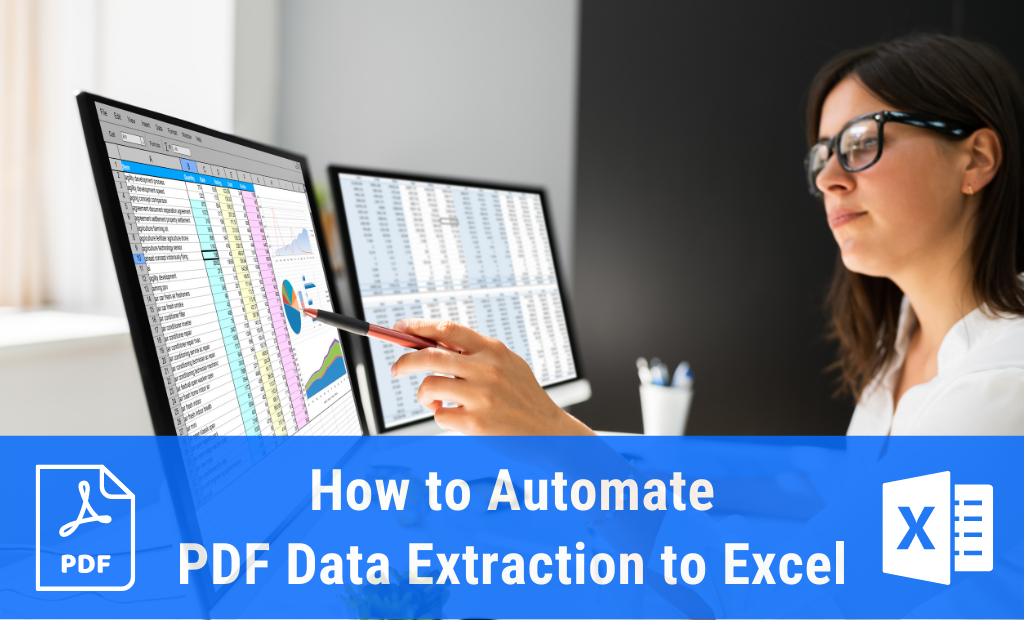Most of the time, PDF files only allow you to download, view, print, and send information. So to manipulate data, you need to move it from PDF to another format. Excel in particular is very useful for editing data, keeping a database, performing calculations and analyses, etc. The best way is to automate PDF data extraction to Excel. In this post, you are going to learn the different ways of moving data from PDF to Excel, and why automation is the best option for your business needs.
Automate PDF Data Extraction with Docparser
Extract data from batches of PDFs exactly how you want it
No credit card required.
How to Move Data from PDF to Excel
There are many different ways to move data—particularly tables—from PDF documents to Excel. Let’s go over the main options you have and see which one is the most efficient.
Copy and paste data manually
The most basic method to move data from PDF to Excel is to copy and paste it manually. This can work well if you only have one or a few PDF files, but if you receive several PDFs every day, then it’s just not viable.
Furthermore, sometimes a PDF file will prevent you from copying information in the first place, so you will have to type all that data by yourself on Excel. But let’s face it: no one looks forward to doing this, especially when you have a large amount of data to enter. Plus, manual data entry leads to mistakes. In fact, new research found that 12% of spreadsheets contain serious errors. So you need a way to move data from your PDFs to Excel.
Import data from PDF to Excel
Did you know that it’s possible to import data directly from a PDF into Excel? This is one of the many convenient features of Excel. The process is very simple and goes like this:
- Go to the ‘Data’ tab and click on ‘Get Data’
- Head over to ‘From File’ and select ‘From PDF’.
- Locate your PDF on your computer and click on ‘Import’
- Select the table and page you want then click on ‘Load’
This is a pretty straightforward method of moving data from a PDF into Excel. However, depending on the complexity of the tables in your document, there may be some formatting errors that need editing. Additionally, this method isn’t very efficient if you have multiple documents to process on a daily basis.
Use a PDF to Excel converter
Nowadays, you can find many online converters with a quick Google search. They are very easy to use: you upload your PDF, click on a button to start the conversion, wait for a few seconds, and download your Excel file. It doesn’t get much simpler than that and you can expect a good result.
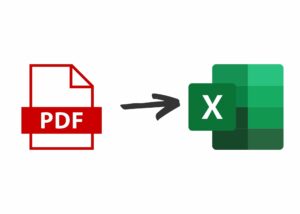
However, these converters are not really designed for scalability. Even when the extracted data is accurate, uploading and downloading files every day is tedious, especially if you have to contend with usage limitations like a set number of conversions per day. Add to that the inability to extract specific data fields instead of the entire document, and you might find yourself spending hours editing and cleaning up your extracted data.
Use an automated PDF to Excel data extraction solution
The last method we’re covering is the most efficient one if you have a recurring need to extract data from PDF to Excel. You can automate PDF data extraction to Excel.
Docparser is a web-based document processing application built for the needs of organizations that process large numbers of documents regularly.
- Choose the specific data fields you want to extract
- Clean up each data field once, so that all documents are processed the same way
- Extract table data from scanned documents
- Extract data from PDF to other formats and even to a cloud application
Thanks to these features, you can overcome the limitations of the other methods we discussed above. Beyond basic PDF to Excel data extraction, Docparser gives you the flexibility and scalability you need to extract any number of PDF documents to Excel, exactly how you want to.
Automate Your PDF Data Extraction to Excel
Extract data from PDFs to Excel quickly and easily with Docparser.
No credit card required.
How to Extract Data from PDF to Excel Automatically
1. Create a Document Parser
First, sign up for a Docparser free trial. Once you do, you will land on your dashboard where you will see a library of pre-set templates for different types of documents. Choose the template that matches the type of document you want to parse. If you don’t find the right type among the options suggested, simply select ‘Custom Template’.
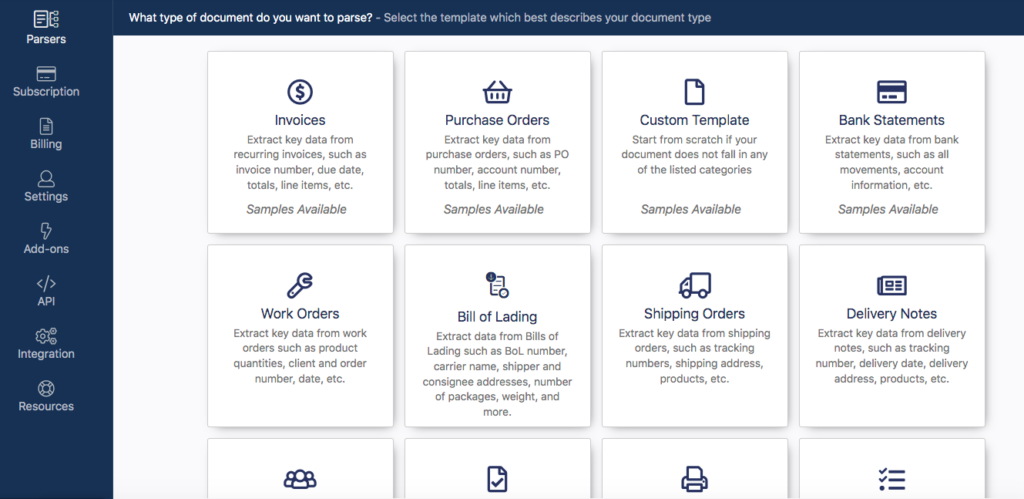
Pro tip: you can create multiple Document Parsers, each for a type of document with a specific layout (an invoice, a bank statement, etc.).
2. Upload a sample PDF
Upload one (or several) PDF(s) from your hard drive, or just drag and drop it. You can also connect your cloud storage provider or send your PDF as an email attachment.
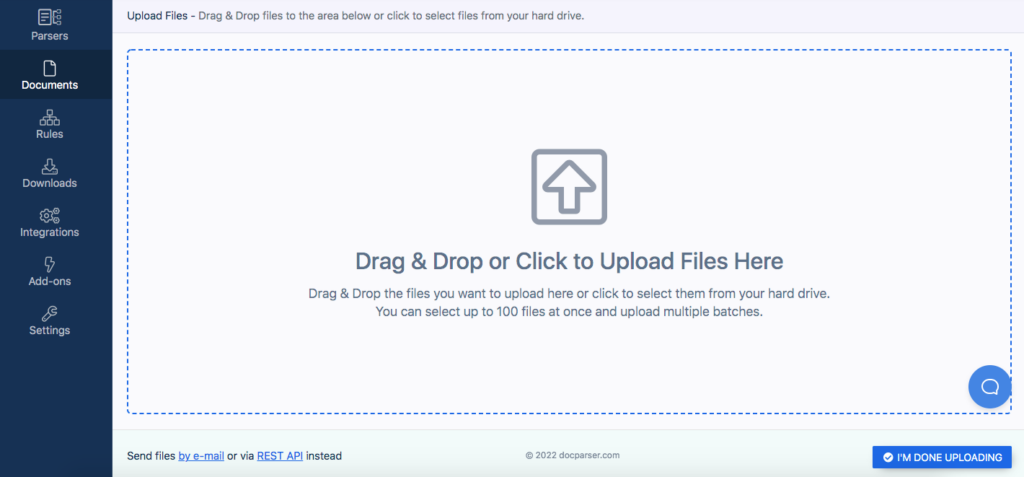
After that, click on ‘I’m Done Uploading’ and type a name for your Parser.
3. Create Parsing Rules for table data extraction
Docparser uses Parsing Rules set by the user to determine where to look for data in a document and extract it. You want to create a Rule for each data field in your PDF.
Create a Parsing Rule for extracting your table
Go to ‘Rules’ on the left-hand side panel and click on the button ‘Create First Parsing Rule’.
In the Parsing Rule editor, you’ll find various Parsing Rules for all sorts of data, from text to names, addresses, phone numbers, tables, etc. For this example, we are going to extract a table, so select ‘Table Data’. The editor will open your document so you can freely select where the table starts and where it ends. You can also add sliders to specify where each column starts and ends.

When you’re done, click on ‘Confirm’ and the editor will show you a preview of the extracted data. Make sure everything is accurate and formatted the way you want it to be. If not, you can add table filters to further clean up your data.
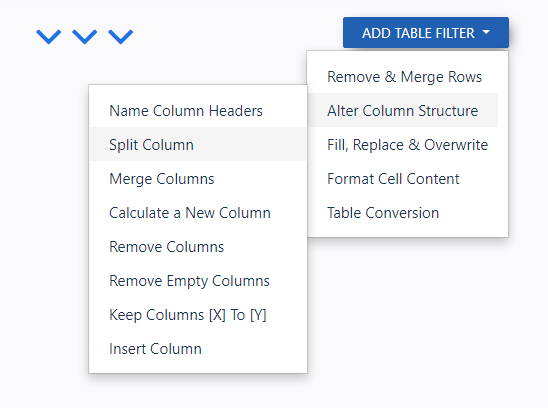
There many different filters you can chain up, including:
- Remove specific rows or columns
- Name column headers
- Split or merge columns
- Search and replace text
- Format dates, numbers, and blank spaces
- And a lot more
Once your data is structured the way you want it, click on ‘Save Parsing Rule’. A prompt will pop up, asking you whether to add another Rule, exit and re-parse your document, or stay in the editor.
Add a new Rule for every additional data field you need. After adding the last Rule and as the dialog box pops up again, select the option ‘Exit & Re-Parse Documents’.

4. Download your parsed data to Excel
We’re almost done! Go to the ‘Downloads’ section of your dashboard and choose Excel from the download formats. As shown in the screenshot below, you can download parsed data not only in Excel format, but also as a CSV, JSON, or XML file.
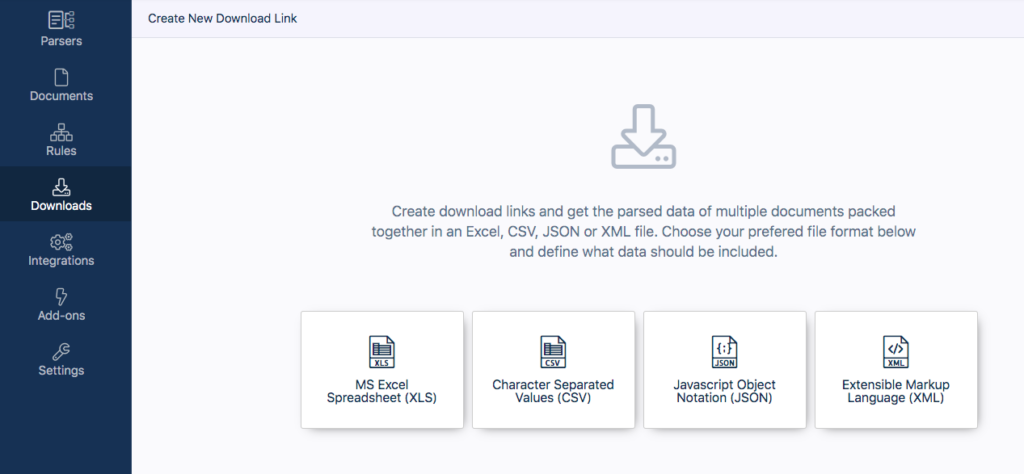
Type a name for your Excel file and choose the range of parsed files that you want. For example, you can download the last 100 files, or the files received today.
Next, click on ‘Save’ and Docparser will generate a download link; click on it and save your Excel file to your hard drive. Voilà!
Optional: send your parsed data to a cloud app
If you typically import Excel files into a cloud application, why not connect Docparser to it to further streamline the data extraction process?
For example, you could set Docparser to move data from PDFs to Google Sheets. Or you can connect Docparser to Zapier which allows you to send parsed data to thousands of cloud apps.
To set up an integration with a cloud application, go to the ‘Integrations’ section of your account and choose one of the integration options.

and follow the instructions provided. Most of the time, these instructions consist simply of logging in to your account on the desired app, and specifying the location where you want data to go.
Now that you are done setting up your Parsing Rules and desired output, you can:
- Import any number of PDFs (with the same layout)
- Process them with Docparser
- Either download them as a single Excel file, or send the parsed data to your desired cloud app
One last thing: while this section focused on PDF table extraction, there’s a lot more you can do with Docparser: you can extract data from Word files and scanned documents as well.
If you’d like to watch a video of how to extract tables from PDF with Docparser, here is a short video on our YouTube channel:
Docparser Use Cases
To get a clearer picture of how businesses benefit from using Docparser, below are two use cases of PDF data extraction to Excel.
The first is a company called Sistema Plastics, a major manufacturer of plasticware based in New Zealand.
“We receive some of our purchase orders from customers in a variety of PDF formats and these can be very long and complex to process. We used to have to manually rekey this information from PDFs into Excel for review and importing to our ERP system. Since implementing Docparser we have been able to set up rules for each customer that quickly extract the order details into Excel in a useful format. Docparser has been invaluable and has reduced processing time of some orders from many hours down to minutes. By removing rekeying we have also increased order accuracy and reduced errors. There are other extraction tools available online, but what made Docparser stand out to us was the wide range of extraction rules available to cope with even the most complicated PDF formats.”
Chris – Sistema Plastics
Another company uses Docparser to process thousands of PDF invoices efficiently per month. Not only have they saved countless hours of work, but their data quality improved a lot too, since automation eliminates human error.
“We needed to manage thousands of PDF invoices and were typing up the details manually. We found Docparser and it has been amazing. We created parsing rules that allowed us to take very fragmented data and get it into an orderly format that can be pulled into excel. There are multiple PDF formats and all could be pulled in with Docparser through their flexible tools. We are converting about 3500 invoices per month but expect this to grow significantly in the future. This tool is giving us a simple way to grow our business because it is automating tasks that used to take hours. The best part is our previous process was prone to errors which this eliminates. In my searching for solutions, I did not find anything else that would do what Docparser does that would be simple, cloud based and affordable.”
Adam L., president of a transportation and trucking company
In Conclusion
If you have a recurring need for extracting business data from PDF to Excel, then you should automate PDF data extraction to Excel. As we saw in this post, rekeying data manually costs too much time and money. And using converters that aren’t built for flexibility and scalability is not viable either. So your best option is to use a data extraction tool that a) gives you the freedom to choose which data to pull and b) can parse as many documents as needed all at once.
Docparser does that and more. Anyone in your organization can set up their own Parser and automate entire document-based workflows. Docparser is easy to learn and requires very little direct input once set up. If this sounds like it could boost your productivity and improve the quality of your data, sign up for a free trial and create your tailored tool for PDF data extraction to Excel.
Automate PDF Data Extraction to Excel with Docparser
No more manual data entry. Save countless hours of tedious work by automating your document-based workflows.
No credit card required.

